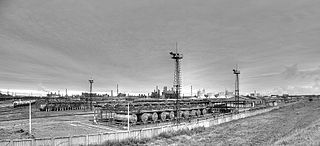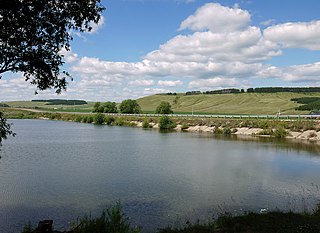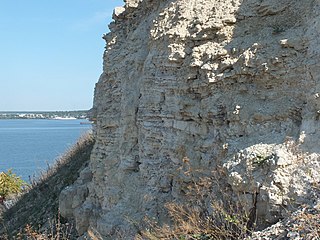
The Republic of Tatarstan, or simply Tatarstan, formerly also called Tataria, is a republic of Russia located in Eastern Europe. It is a part of the Volga Federal District; and its capital and largest city is Kazan, an important cultural centre in Russia.

Kazan is the capital and largest city of the Republic of Tatarstan in Russia. The city lies at the confluence of the Volga and the Kazanka rivers, covering an area of 425.3 square kilometres, with a population of over 1.2 million residents, up to roughly 1.6 million residents in the urban agglomeration. Kazan is the fifth-largest city in Russia, and the most populous city on the Volga, as well as the Volga Federal District.

PJSCKazanorgsintez is one of Russia's largest chemical companies and the country's largest polyethylene producer. It is based in Kazan, Tatarstan.

Alexeyevsky District is a territorial administrative unit and municipal district of the Republic of Tatarstan within the Russian Federation. It is located in the central part of the region, on the left bank of the Kama river. The administrative center of the district is the urban-type settlement of Alekseevskoe.

Drozhzhanovsky District — is a territorial administrative unit and municipal district of the Republic of Tatarstan within the Russian Federation. It is located in the southwestern part of Tatarstan. The administrative center of the district is the village of Staroye Drozhzhanoye. The district population at the beginning of 2020 was 21,569.

Kukmorsky District is a territorial administrative unit and municipality of the Republic of Tatarstan within the Russian Federation. The district is located in the north of the republic and occupies a total area of 1,493 square kilometers (576 sq mi). According to the 2010 census, the municipality had a population of 52,021. As of 2020, the district population was 51,567 people. The administrative center of the district is the urban-type settlement of Kukmor which accounts for 32.5% of the district's total population.

Laishevsky District (Russian: Лаи́шевский райо́н; Tatar: Лаеш районы – is a territorial administrative unit and municipal district of the Republic of Tatarstan within the Russian Federation. It is located in the western part of the republic at the confluence of the Volga and Kama rivers. The administrative center of the district is the city of Laishevo.

Mendeleyevsky District is a territorial administrative unit and municipal district of the Republic of Tatarstan within the Russian Federation. The district is located on the right bank of the Kama and on the Toyma River, 238 kilometers from Kazan. The administrative center of the district is Mendeleyevsk. At the beginning of 2020, the population of the district was 30,064.

Menzelinsky District is a territorial administrative unit and municipal district of the Republic of Tatarstan within the Russian Federation. The district is located on the right bank of the Kama River, in the north-eastern part of the Republic of Tatarstan. The administrative center is Menzelinsk.

Nizhnekamsky District is a territorial administrative unit and municipal district of the Republic of Tatarstan within the Russian Federation. The district is located on the left bank of the Kama River. The administrative center of the district is Nizhnekamsk and the population of the district was 276,326 at the beginning of 2020.

Tetyushsky District – is a territorial administrative unit and municipal district of the Republic of Tatarstan within the Russian Federation. The district is located in the south-west of Tatarstan, on the right bank of the Kuybyshev Reservoir, and shares borders with the Ulyanovsk Oblast, Buinsky, Apastovsky and Kamsko-Ustyinsky District. The administrative center of the district is the city of Tetyushi.

Verkhneuslonsky District is a territorial administrative unit and municipality of the Republic of Tatarstan within the Russian Federation. The district is located in the west of the republic on the right bank of the Volga River and encompasses a total area of 1,373.9 square kilometers (530.5 sq mi). According to the 2010 census, the municipality had a population of 16,641 people. Its administrative center, the selo (village) of Verkhny Uslon, accounts for 27% of the district's total population.

Vysokogorsky District is a territorial administrative unit and municipal district of the Republic of Tatarstan within the Russian Federation. The administrative center of the district is the village of Vysokaya Gora. The district population at the beginning of 2020 was 51,567.

Zelenodolsky District — is a territorial administrative unit and municipal district of the Republic of Tatarstan within the Russian Federation. The district is divided by a channel of the Volga river into sections on the right-bank and left-bank. The administrative center of the district is Zelenodolsk. At the beginning of 2020, the population of the district was 165,915.

RVC (JSC) is a state fund of funds and a development institute of the Russian Federation, one of Russia's key tools in building its own national innovation system.
Street Ğädel Qutuy is a highway in the city of Kazan, Republic of Tatarstan, Russia. It is named in the honor of Tatar writer, poet and playwright Ğädel Qutuy. The highway connects the eastern part with the central part of the city. The highway runs from north-west to south-east.
Marat Faridovich Zagidullov is a Tatar businessman, investor, and politician. He is also a former city manager of Kazan, former deputy of the State Duma, member of the United Russia political party, and co-owner of the scientific and production company Potok Inter.

Airat Khairullin was a Russian economist, millionaire-businessman, and politician-statesman from Tatarstan. He served as a member of the State Duma between 2003 and his death in 2020. Within the Duma, he was a member of the Agriculture Policy Committee.

![Korston-Kazan [ru] with local World Trade Center Korston Hotel&Mall Kazan 3.jpg](http://upload.wikimedia.org/wikipedia/commons/thumb/3/32/Korston_Hotel%26Mall_Kazan_3.jpg/220px-Korston_Hotel%26Mall_Kazan_3.jpg)
























